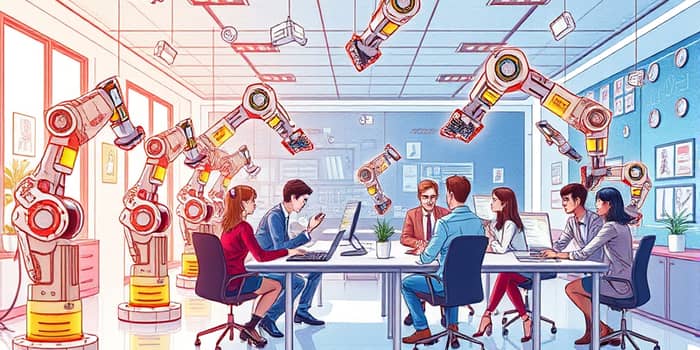
In a landscape defined by rapid change and relentless competition, the pursuit of consistency often feels like chasing the horizon. Whether you lead a Fortune 500 enterprise or manage a small team, maintaining steady performance over weeks, months, or years demands more than discipline; it requires a deliberate shift toward automated workflows that underpin reliable execution. By harnessing technology to shoulder repetitive tasks, organizations can free human ingenuity for higher-value work and build a resilient foundation that weathers the storms of uncertainty.
Imagine a scenario where every task, no matter how tedious, completes itself flawlessly while you focus on strategy, creativity, and human connections. This shift is not a distant dream but a present reality for companies embracing automation. As workflows become self-driving, teams rediscover the joy of innovation and leaders gain confidence in predictable outcomes.
Statistics reveal a staggering reality: 94% of companies grapple with time-consuming, repetitive tasks that hamper growth and introduce variability. Manual processes not only sap morale but also breed errors that ripple across departments. Embracing automation transforms this dynamic by offloading routine operations to machines, ensuring tasks execute consistently, on time, and without fatigue. In essence, automation reduces human error and ensures uniform performance, establishing the bedrock for sustained excellence.
Moreover, over 90% of workers report feeling more productive once automation handles mundane duties. When teams no longer dread repetitive tasks, creativity flourishes, and innovation takes center stage. The real triumph lies in converting friction into flow, as organizations pivot from firefighting day-to-day issues to architecting scalable solutions for tomorrow.
The automation landscape in 2025 is nothing short of transformative. Structured automation adoption has surged to 70% of organizations, up from a mere 20% in 2021. Robotic Process Automation (RPA) has transitioned from a novelty to a necessity, with 78% of companies implementing or planning RPA initiatives. Across sectors—finance, manufacturing, sales, and even content production—automation is redefining workflows and amplifying impact.
From rule-based scripts that process invoices in seconds to AI-driven engines that optimize marketing campaigns in real time, businesses can eliminate mundane tasks that drain creativity and redirect focus toward strategic imperatives. The fusion of RPA, AI, and intelligent workflow tools heralds an era of hyper-automation where the only limit is imagination.
The global automation market is on an explosive growth trajectory. Industrial automation, valued at $206B in 2024, is projected to exceed $264.69B by 2026, fueled by a 10.8% CAGR through 2030. Meanwhile, the RPA sector, already commanding $22.79B in 2024, anticipates continued expansion at a remarkable 43.9% CAGR between 2025 and 2030. Asia-Pacific leads industrial gains with approximately 39% of revenue, while North America spearheads financial process automation.
These figures underscore not only the scale of opportunity but also the momentum behind digital transformation initiatives worldwide. Organizations that seize the moment can carve out lasting advantages in productivity and resilience.
Automation delivers tangible business outcomes that resonate on balance sheets and in boardrooms. Sales teams leveraging automated lead scoring and follow-ups report a 14.5% boost in productivity and a 22% average reduction in operating costs. Robotic Process Automation projects can yield 30% to 200% ROI within the first year, with long-term returns reaching up to 300%.
By centralizing data collection and orchestrating end-to-end flows, companies gain deep insights into productivity and ROI. When metrics are transparent and continuously monitored, leaders can make informed decisions, reallocate resources swiftly, and scale successful automations across functions. Consistent reporting becomes more than a compliance checkbox—it evolves into a strategic compass guiding perpetual improvement.
Despite its promise, automation is not a silver bullet. Research indicates that 70% of digital transformation projects falter due to poor execution, lack of stakeholder alignment, and undefined processes. Avoiding these pitfalls demands a holistic approach that balances technology, people, and change management.
With a robust governance framework and a culture of experimentation, organizations can transform failures into learning experiences and build a roadmap for scalable automation.
A strategic blueprint is the cornerstone of lasting consistency. Rather than automating everything at once, start with high-impact bottlenecks and expand iteratively. Integrate systems for end-to-end visibility, ensuring seamless handoffs between sales, finance, operations, and marketing.
By aligning technology roadmaps with organizational goals, leaders can integrate AI, RPA, and workflow tools in a coherent fashion, laying the foundation for lasting success that compounds over time.
At its core, automation is a tool to amplify human potential. Sixty-eight percent of employees report feeling overwhelmed by repetitive tasks; automation acts as a relief valve, freeing minds from monotony and reducing burnout. When systems handle scheduling, reporting, and approvals, teams can devote energy to creativity, problem solving, and collaboration.
On a personal level, individuals can automate reminders, tracking, and reporting seamlessly, embedding healthy habits and ensuring priorities never slip through the cracks. Robots do the routine, while people focus on innovation and relationship building, creating a virtuous cycle of engagement and results.
Consistency is not an innate trait but an engineered outcome. By thoughtfully deploying automation across processes—from back-office finance to front-line sales outreach—organizations can deliver predictable, high-quality outputs that win trust and drive growth.
Remember to measure, refine, and scale, transforming workflows into assets rather than liabilities. Embrace automation not as a threat to human roles but as a partner in the quest for excellence. When machines handle the mundane, people can aspire to the extraordinary and transform routines into reliable, measurable outcomes that propel businesses toward a brighter future.
References













